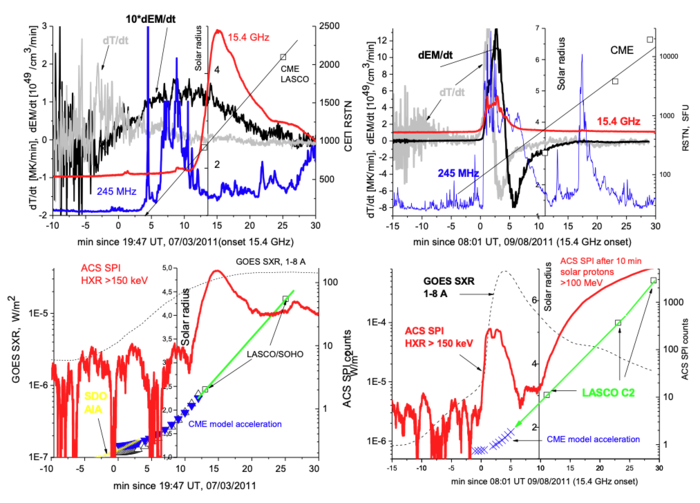Impulsive and Gradual Eruptive Gamma Flares and Associated CMEs
From RHESSI Wiki
| Nugget | |
|---|---|
| Number: | 413 |
| 1st Author: | Alexey STRUMINSKY |
| 2nd Author: | Irina GRIGORIEVA and Andrei SADOVSKI |
| Published: | 19 July 2021 |
| Next Nugget: | Flares and CMEs |
| Previous Nugget: | The Morphology of Flare Time Profiles |
| List all | |
Contents |
Introduction
The first results of solar >100 MeV gamma ray observations by [Fermi/LAT] were presented 10 years ago at the ICRC 2011 conference in Beijing, and noted in earlier RHESSI Science Nuggets: 179; 227; 268; 300; 325; 370; 373. By now the catalogue of Long Duration Gamma Ray Flares (LDGRF) includes more than 30 such events, but the nature of long-duration gamma-ray emission remains uncertain: is it prolonged proton acceleration or is it trapping; is it the flare or the CME shock acceleration? These questions are closely related to the problems of the origin of SEPs solar energetic particles). the flare-CME relationship, and the very definition of an eruptive flare.
According to Z. Svestka (Ref. [1]), the term "eruptive flare" was introduced for all solar active phenomena, which lead to mass ejections resulting in a CME (with or without effects in the chromosphere). The appears to be a unique process operating in eruptive flares, with differences resulting from the configuration of the pre-event magnetic plasma (i.e. the height and density). Below we illustrate the flare-CME relationship using examples of two famous flares from the LDGRF list, described in Refs. [2,3]. (1) the gradual M3.7 flare SOL2011-03-07; and (2) the impulsive X6.9 flare SOL2011-08-09.
Data
Figure 1 shows data overviews for the two events (note the difference of about two orders of magnitude between the maximum values of dEM/dt for SOL2011-03-07 and for SOL2011-08-09). We have assembled information on: plasma heating (SXR observations from GOES, temperature T and emission measure EM), thence dT/dt and dEM/dt; plasma motions in the flare region (dEM/dt, plus images obtained by SDO/AIA, frequency drifts at radio frequencies (1415-245 MHz from [https://en.wikipedia.org/wiki/Radio_Solar_Telescope_Network RSTN); electron acceleration (microwaves (15.4-2.695 GHz, also from RSTN) and HXR > 150 keV (the INTEGRAL anticoincidence shield; CME positions from LASCO/SOHO; proton acceleration via γ-rays > 100 MeV from Fermi/LAT, and SEPs (protons > 100 MeV), also from INTEGRAL.
The gradual M3.7 flare SOL2011-03-07 was followed by >100 MeV γ-ray emission during 25 min after 20:15 UT (+28 min) and over 13 hr later (LDGRF). The impulsive X6.9 flare SOL2011-08-09 was accompanied by >100 MeV γ-ray emission for only 3.3 min after 08:01 UT (0 min), Due to arrival of solar protons the ACS SPI count rate showed a small and slow rise after 20:17 UT (+30 min) on 07/03/2011, but a large and sharp increase at 08:11 UT (+10 min) on 09/08/2011.
Based on these observations we conclude that: 1) the CME associated with the gradual flare, SOL2011-03-07 (with weaker chromospheric effects and GOES class only M3.7) was accelerated for a longer period but at a smaller rate. The non-thermal electrons did not reach the chromosphere (coronal sources of HXR and radio emission were observed when the CME was at Rs>2); 2) the CME associated with impulsive flare (strong chromospheric effects) - X6.9 SOL2011-08-09 was accelerated quickly during the period of effective chromospheric evaporation (between Tmax and EMmax), and decelerating after that; 3) maximal velocity of both CMEs is ~2100 km/s and corresponds to the Alfven velocity available in the CME acceleration region. Finally, 4) Since the properties of the LDGRFs reflect the characteristics of the flares, but not the CMEs, the >100 MeV γ -ray emission is caused by protons accelerated during the flares.
The proposed scenario
The cartoon of Figure 2 illustrates the processes involved:
Left - Acceleration of non-thermal electrons with soft spectrum occurs at heights ~105 km (plasma frequency fp ~ 245 MHz, electron densityne < 7.4x108 cm-3) in (1), electrons heat surrounding plasma, EM is practically constant, the magnetic flux rope is confined, the electron spectrum becomes eventually harder.
Middle - The acceleration site moves from (1) to (2), a new acceleration site (3) may appear by chance, T is increasing. If the acceleration site (3) is close to the chromosphere then the chromospheric evaporation starts (the case of SOL2011-08-09). The acceleration of CME continues up to ~3.5x105 km due to plasma expansion. Stochastic particle acceleration in (1), (2) and (3), as proposed in Nugget No. 373.
Right - Further the CME (plasma above closed field lines of active region including the magnetic flux rope) moves with constant velocity or with small acceleration/deceleration. Particles (electrons <10 MeV, protons > 100 MeV) are accelerating stochastically below the CME in (4) as described in Nugget No. 373.
References
[1] "On 'The Solar Flare Myth' postulated by Gosling"
[3] "Characteristics of Late-phase >100 MeV Gamma-Ray Emission in Solar Eruptive Events"
| RHESSI Nugget Date | 19 July 2021 + |
| RHESSI Nugget First Author | Alexey STRUMINSKY + |
| RHESSI Nugget Index | 413 + |
| RHESSI Nugget Second Author | Irina GRIGORIEVA and Andrei SADOVSKI + |

